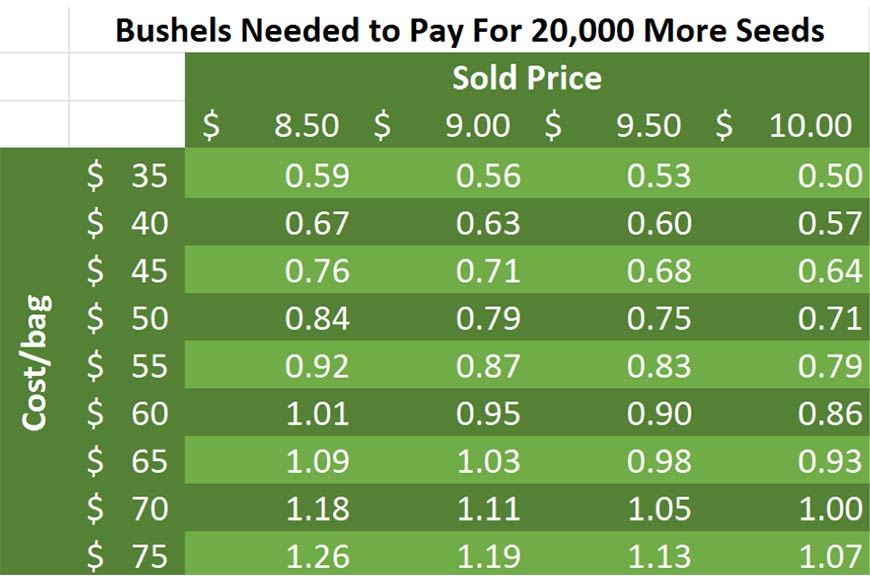Variable-rate Soybeans: Your Answer for Higher Margins?

Variable-rate soybeans provide a unique opportunity to lower seed costs during a time of slim margins. If you have planted variable rate in corn, you might be wondering how this is possible. The way variable rate works in soybeans is the exact opposite: As your yield potential rises, you should lower your planting rate; and as your yield potential falls, you should increase your planting rate. It seems strange to invest more when yield potential is lower, but there is a reason.
Germination
Soybean seed bags guarantee 85 percent germination. As you plant in your tougher areas, do you think you are going to get 100 percent of that 85 percent germination rate? In reality, no; your success rate may be far lower due to poorer conditions. Now consider the high-yielding areas of the field. Is there a chance you are achieving germination rates of 85 percent or higher? Yes, as the conditions of high-yielding areas often include good soil and drainage. You may be under-populating your low-yield areas and over-populating your high-yield areas.
Economics
As I discussed in “Variable-rate Corn Won’t Save You Money,” we often expect an ROI that’s 10 times our investment. We need to realize this may not always happen, especially as we chase consistent 100-plus bushel-per-acre soybean averages.
The hardest concept to understand is that if we lower planting rates from 160,000 seeds per acre to 140,000 seeds per acre in a zone, we can afford to raise 1 less bushel and make the same amount of money. As you lower seeding rates, you reduce seed costs; however, this is not money that should be stored for next year. These dollars can provide for increased herbicide programs, seed treatments and fungicides, which offer a greater chance for higher yield potential.
Yield Potential Increase
You might be wondering where that yield bump will come from — the higher populations or the lower populations? Since soybean prescription populations are backwards, we see the breakeven point is lower in high-yielding environments. It has been observed that that as we lower these populations, we are actually increasing soybean yields. This increases your margin, since the seed investment is lower, but the production goes up.
There is no right answer as to what a good yield increase is for soybeans, but it is best to compare the zones against one another as well as against previous years. A few bushels may not seem like much, but when you look at your reduced input amount, it adds a good amount to the bottom line.
Prerequisites
If you are thinking about planting variable-rate soybeans, there are a few things you must ensure are in order to optimize yield potential.
Germination
Soybean seed bags guarantee 85 percent germination. As you plant in your tougher areas, do you think you are going to get 100 percent of that 85 percent germination rate? In reality, no; your success rate may be far lower due to poorer conditions. Now consider the high-yielding areas of the field. Is there a chance you are achieving germination rates of 85 percent or higher? Yes, as the conditions of high-yielding areas often include good soil and drainage. You may be under-populating your low-yield areas and over-populating your high-yield areas.
Economics
As I discussed in “Variable-rate Corn Won’t Save You Money,” we often expect an ROI that’s 10 times our investment. We need to realize this may not always happen, especially as we chase consistent 100-plus bushel-per-acre soybean averages.
The hardest concept to understand is that if we lower planting rates from 160,000 seeds per acre to 140,000 seeds per acre in a zone, we can afford to raise 1 less bushel and make the same amount of money. As you lower seeding rates, you reduce seed costs; however, this is not money that should be stored for next year. These dollars can provide for increased herbicide programs, seed treatments and fungicides, which offer a greater chance for higher yield potential.
Yield Potential Increase
You might be wondering where that yield bump will come from — the higher populations or the lower populations? Since soybean prescription populations are backwards, we see the breakeven point is lower in high-yielding environments. It has been observed that that as we lower these populations, we are actually increasing soybean yields. This increases your margin, since the seed investment is lower, but the production goes up.
There is no right answer as to what a good yield increase is for soybeans, but it is best to compare the zones against one another as well as against previous years. A few bushels may not seem like much, but when you look at your reduced input amount, it adds a good amount to the bottom line.
Prerequisites
If you are thinking about planting variable-rate soybeans, there are a few things you must ensure are in order to optimize yield potential.
- A good seed treatment is an absolute must.
- If you have weed pressure, invest in a robust herbicide program.
- If you miss the optimal planting window, adjust your planting rates accordingly. If you are planting late, adjust each zone up in population to compensate for adverse conditions.


